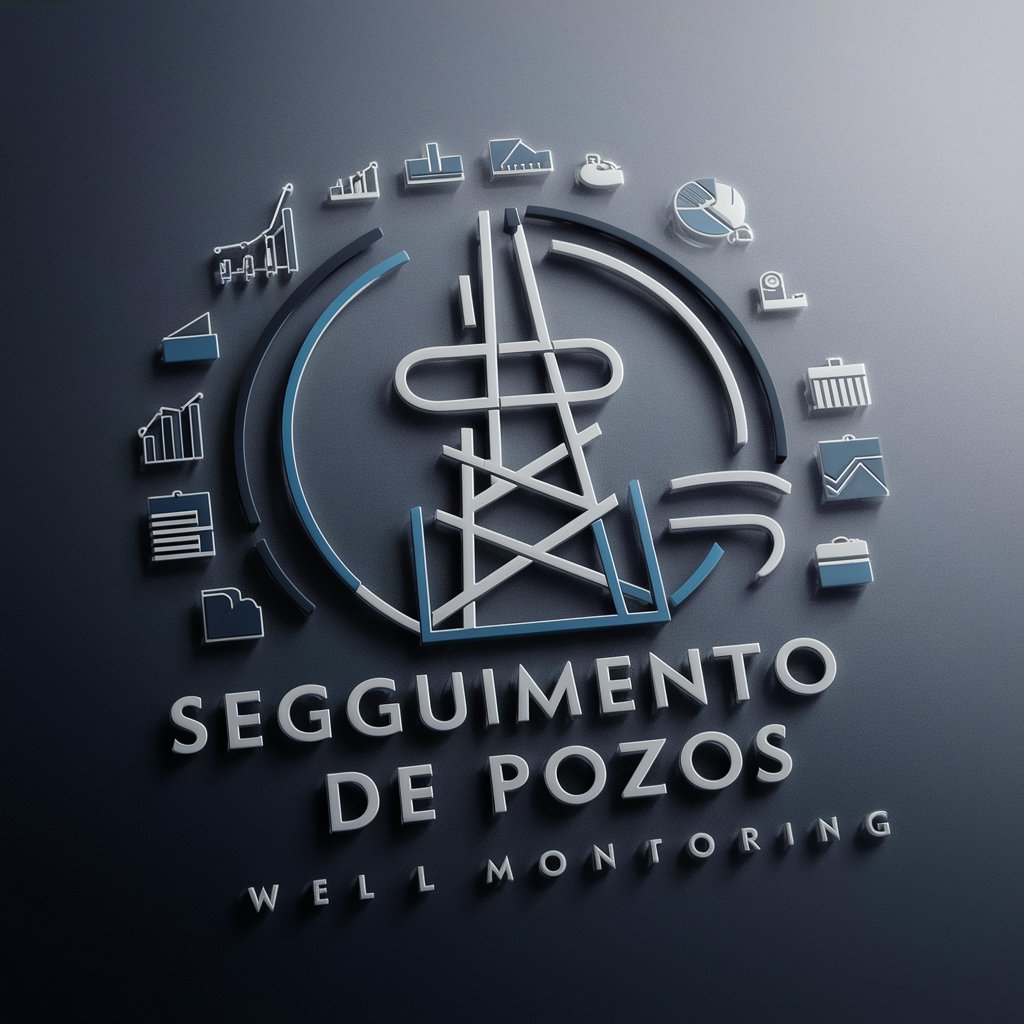Seguimiento de Pozos - Well Performance Insights

Welcome to Seguimiento de Pozos, your reliable well monitoring assistant.
Optimizing well operations with AI-driven insights
Analyze the data trends from the last well monitoring report and summarize key findings.
Generate a weekly performance report for the well based on the provided data set.
Explain the variations in PIP and THP readings from the most recent monitoring data.
Provide a summary of fluid production trends observed in the latest well data.
Get Embed Code
Introduction to Seguimiento de Pozos
Seguimiento de Pozos, or Well Monitoring in English, is a specialized tool designed to assist in the comprehensive monitoring and analysis of oil and gas well operations. Its primary function is to aggregate, analyze, and report on various operational parameters that influence well performance over time. These parameters include but are not limited to choke settings, tubing head pressure (THP), water cut (S&W percentage), frequency of pumps, pump intake pressure (PIP), motor temperature, vibration levels, electrical current and voltage to the motor, and the production rates of oil, water, and total fluids, as well as chloride content in the water. By evaluating these parameters, Seguimiento de Pozos provides insights into the well's operational status, identifying trends and potential issues that could affect production efficiency and equipment integrity. For example, by analyzing the trends in THP and PIP, the tool can help in determining the optimal pump settings to maintain or enhance oil recovery rates, while monitoring S&W and chloride levels could indicate potential water breakthrough or scaling issues. Powered by ChatGPT-4o。

Main Functions of Seguimiento de Pozos
Data Aggregation and Analysis
Example
Gathering real-time and historical data from various sensors and logs to analyze performance trends.
Scenario
In a scenario where a well shows gradual increases in water cut, the system can alert operators to potential water breakthrough, enabling early intervention to optimize water management strategies.
Operational Insight and Reporting
Example
Generating comprehensive reports detailing well performance post-startup, highlighting key parameters and trends.
Scenario
After a new pump installation, the tool analyzes data to report on the well's performance, including any deviations in expected production rates or equipment behavior, facilitating quick adjustments.
Trend Identification and Predictive Analysis
Example
Identifying patterns in pressure fluctuations, fluid production rates, and equipment behavior to predict future performance issues.
Scenario
By recognizing patterns in motor temperature and vibration data, the tool can predict potential equipment failures before they occur, allowing for preemptive maintenance.
Ideal Users of Seguimiento de Pozos Services
Production Engineers
Professionals responsible for optimizing well performance will find Seguimiento de Pozos invaluable for analyzing data to make informed decisions on operations, from pump speeds to choke adjustments.
Operations Managers
Managers overseeing field operations can utilize the tool's reporting and predictive analysis features to ensure that wells operate within their optimal parameters, minimizing downtime and maximizing production efficiency.
Maintenance Teams
Maintenance personnel can benefit from the system's trend analysis and predictive capabilities to schedule preventive maintenance, thereby reducing unexpected equipment failures and ensuring continuous operation.

How to Use Seguimiento de Pozos
Begin Your Journey
Start by visiting yeschat.ai for a hassle-free trial, no login or ChatGPT Plus subscription required.
Prepare Your Data
Gather your well-monitoring data, focusing on key metrics such as CHOKE, THP, S&W, and more, as outlined in the tool's requirements.
Enter Your Data
Input your collected data into the Seguimiento de Pozos interface, ensuring accuracy and completeness for optimal analysis.
Analyze the Output
Review the comprehensive well behavior analysis provided, noting any trends, patterns, or anomalies in your data.
Apply Insights
Utilize the insights gained from the analysis to make informed decisions regarding your well's operation and maintenance.
Try other advanced and practical GPTs
Eddie v2.0
Crafting Inclusive Communications with AI

WB Guide Bot
Your AI-Powered Whistler Blackcomb Concierge

Whistler
Your AI-powered guide to Whistler, Canada

Rob Burbea Seeing That Frees Book Companion
Unlocking emptiness for profound freedom

Timeless Wisdom of Rob Burbea
Explore the depths of consciousness and perception.

C# Companion
Elevate your C# projects with AI-powered expertise.

IoT Project Assistant
Empowering Smart Homes with AI

Let's Get Rich Coach
AI-Powered Path to Entrepreneurial Success

Insta Profile Helper | Level Up Your Social Media
Elevate Your Instagram Game with AI

CodeCreator
Empowering Your Web Creations with AI

Wisdom | Path to Greatness
Unlock your potential with AI-powered guidance.

C.C. the Co-Founding Collaborator
Empowering your entrepreneurial journey with AI.

Detailed Q&A about Seguimiento de Pozos
What data does Seguimiento de Pozos require for analysis?
Seguimiento de Pozos needs data including but not limited to CHOKE size, THP (Tubing Head Pressure), S&W (Salt & Water percentage), operational frequencies, PIP (Pressure Intake Pump), motor temperature, vibration, motor current, voltage, and fluid, oil, and water production rates.
Can Seguimiento de Pozos predict future well performance?
While primarily focused on monitoring and analyzing current conditions, Seguimiento de Pozos can help identify trends and patterns that may indicate future performance, although it does not explicitly predict future outcomes.
How often should I update my data for analysis in Seguimiento de Pozos?
For the most accurate and useful insights, it is recommended to update your data regularly, at least after every significant operational change or at daily intervals, depending on the well's dynamics.
Is Seguimiento de Pozos suitable for all types of wells?
Seguimiento de Pozos is versatile and can be applied to a variety of well types, including but not limited to oil, gas, and water injection wells, provided the necessary data for analysis is available.
How does Seguimiento de Pozos enhance operational decision-making?
By providing detailed analysis on well performance, highlighting trends, and identifying potential issues, Seguimiento de Pozos empowers operators to make informed decisions to optimize production, manage resources efficiently, and plan maintenance effectively.
